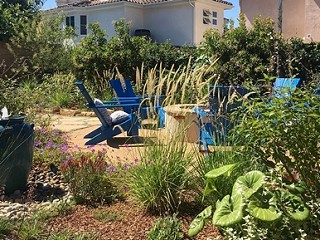Mind Your Water in the Garden

By Lori Palmquist
Despite the deluges we experienced back in October and December of last year, we find ourselves slipping more deeply into a state of drought as spring begins. The Drought Monitor website https://droughtmonitor.unl.edu/Maps/MapArchive.aspx informs us that 100% of California is already in moderate drought, 96% is in severe drought, and 47% is in extreme drought.
The water districts could be asking us to conserve even more this year. The whole state relies on a steady supply of snow and rain the first three months of the year. But very little of this liquid refreshment has fallen thus far. Since drought seems to have settled in, the onus is on us to bring on our best dry game.
Strategies for using less water in the garden
If we want to reduce water use in the garden, there are three overarching principles and actions to achieving this.
- Lower the water needs of the landscape
- Leverage alternative water sources
- Ensure the irrigation is operating efficiently
Lower the water needs of the landscape
Removing lawns and replacing them with low-water plants is the low-hanging fruit of water conservation. This is why cities, water districts, and even the State of California have been offering generous lawn replacement rebates for the past decade. In Walnut Creek, for every 1,000 square feet of lawn that’s removed and replaced with low-water plants, there is a savings of 17,000 gallons a year. That’s enough to supply drinking water for a family of three for three months (based on an average of 64 ounces a day per person).
But it’s currently not a good time of year to remove the lawn and plant new plants. We’re headed into the dry, hot seasons. And getting plants established during our hot summers takes large amounts of water. It’s best to delay the lawn removal and new planting until the fall, when the rainy season will hopefully provide the water to establish the new plants. Here are some useful statistics to know about the amount of water your landscape may require. If you live in the east part of the county in Antioch, Brentwood, or Oakley, these numbers will be higher. If you live in the west, in Richmond, El Cerrito, San Pablo, or parts of El Sobrante, they will be lower.
In Walnut Creek:
- 1,000 square feet of high-water landscape requires 22,866 gallons per year
- 1,000 square feet of moderate-water landscape requires 14,291 gallons per year
- 1,000 square feet of low-water landscape requires 5,716 gallons per year
Leverage alternative water sources
If you were to start planning and implementing a laundry-to-landscape system of sending your recycled washing machine water into the landscape to water your shrubs and trees, this would yield a huge water savings. EBMUD and Contra Costa Water District are both offering generous rebates for this.
But since the rainy season is close to being over, I’m not going to offer any rainwater harvesting projects for you to consider starting. The Contra Costa Water District has some great information on this on their website at the following link. You could do the research now and start your project in the fall. https://www.ccwater.com/859/Rain-Gardens-and-Rainwater-Harvesting
Ensure the irrigation is operating efficiently
Something we CAN do now and SHOULD be doing is spiffing up our irrigation systems. Following are five strategies that can be easily implemented and will net you the reward of using much less water in the landscape this year.
1. Reduce run times on irrigation zones by 10% (or even 20%). When you set your controller’s spring irrigation schedule, put 10% fewer minutes on each station in the controller. So, for every 10 minutes of run time, you’ll take away one minute (or two for 20%). In my experience of assessing hundreds of irrigation systems, I’ve found people usually overwater their landscapes. Most likely you’re overwatering yours, too.
2. Inspect your irrigation system and fix any issues you find. We have a checklist that you can use to inspect your irrigation. You can access it here. This checklist helps you identify issues with your sprinklers and your drip systems. And it gives you direction as to what to do when you find those issues.
3. A practice that will yield big water savings is spreading 2 to 3 inches of mulch over all the planted areas. This holds the water in the soil much longer than bare, exposed soil. A study done at Texas A&M University found that one inch of mulch spread over planted areas lowers the water requirement by 25%. This is because it suppresses the evaporation of water from the soil. It also provides a steady diet for those organisms that bring the earth to life and facilitate the robust water-holding capability of the soil. Both EBMUD and Contra Costa Water District are offering coupons for discounts on mulch.
4. If you’re using sprinklers for your planted areas, now’s a good time to think about converting those sprinklers to drip. Sprinklers in planted areas are usually blocked by plants, rendering the sprinklers useless. The most efficient irrigation we have is drip. This is because it applies water directly to the soil where it’s needed. No blocked spray. No mist flying away. Just the tubing sitting on top of the ground putting the water into the soil. Check with your water district to see if they’re currently offering a rebate for sprinkler-to-drip conversions.
5. Another action that will yield big water savings is changing out that conventional controller to a smart controller. Again, the water districts have great rebates on smart controllers. This could net you a savings of at least 25% of the water you use in the landscape, if correctly programmed. Be diligent about learning how to program the smart controller. It can waste much water if programmed incorrectly.
Call to action
I trust I’ve given you an arsenal of actions that you can use to make a big difference in the amount of water your garden consumes this year. These are simple, yet powerful actions. When you do these things your garden benefits, you benefit, and our beleaguered water supply benefits. Let’s hold onto and nurture our gardens. They provide us with solace in a world that challenges us to find and focus on beauty and grace. I thank you for even the smallest action you take.


